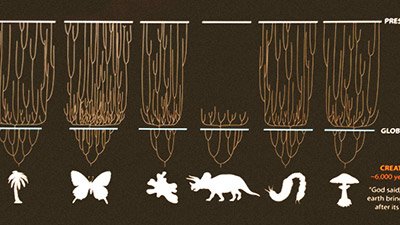
What They Didn't Find
The scene is reminiscent of a movie: intrepid explorers pierce the wilderness and stumble upon a trove of amazing species rarely—if ever—seen before.
News Source
- Guardian.co.uk: “Lost World of Fanged Frogs and Giant Rats Discovered in Papua New Guinea”
In this case, the explorers were a team of scientists from Britain, New Zealand, and the United States who trekked down into a 1 kilometer (0.62 miles) deep and 3 kilometer (1.86 miles) wide crater in Papua New Guinea. Over the course of five weeks, the team documented at least 21 new species or sub-species, including frogs with fangs, fish, and a giant rat that may be the largest currently living. (Some of these are shown in an image gallery on the Guardian’s website.)
Protected in the crater, they still express certain traits that other members of the kind have lost.
To understand how this discovery impacts the creation-evolution debate, we’ll first need to consider what was and was not found. The scientists did discover a number of isolated species that, because of the variety in each created kind, have become remarkably unique. Protected in the crater, they still express certain traits (e.g., frog fangs and rat size) that other members of the kind have lost. (Most frogs, in fact, have teeth.)
Each of these discoveries reminds us of just how much diversity is possible within each created kind since all the land animals departed from the Ark. Much of the information in the genome of those original animals has been expressed, repressed, or lost through speciation and mutation. But the creativity shown in each kind is truly amazing.
What the team did not uncover, however, are examples of what one would expect to find according to evolution. An area such as this crater is a living laboratory for what Darwin predicted: changes from one kind into another kind.
Everything the team discovered fits with animals we’re accustomed to: birds, fish, rats, etc. Even though some of these animals have unique features, there is still no evidence of fish growing legs or salamanders sprouting mammal hair. Frogs with fangs are still frogs. In a similar fashion, creatures on the famous Galápagos Islands, though often cited as evidence of evolution, suffer this same defect (as far as evolution is concerned). Finches and tortoises, no matter the size of their beaks or the shapes of their shells, will always be finches and tortoises.
Natural selection and mutations—even in this pristine wilderness of Papua New Guinea—can do nothing more than work with existing genetic material to cause changes within each kind. In other words, don’t hold your breath for the announcement of the reptiliobird.
Further Reading
- Natural Selection vs. Evolution
- Finding God in Galapagos
- Creation’s Hidden Potential
- Get Answers: Created Kinds, Genetics, Mutations, Natural Selection, Speciation
For More Information: Get Answers
Remember, if you see a news story that might merit some attention, let us know about it! (Note: if the story originates from the Associated Press, FOX News, MSNBC, the New York Times, or another major national media outlet, we will most likely have already heard about it.) And thanks to all of our readers who have submitted great news tips to us. If you didn’t catch all the latest News to Know, why not take a look to see what you’ve missed?
(Please note that links will take you directly to the source. Answers in Genesis is not responsible for content on the websites to which we refer. For more information, please see our Privacy Policy.)

Answers in Genesis is an apologetics ministry, dedicated to helping Christians defend their faith and proclaim the good news of Jesus Christ.
- Customer Service 800.778.3390
- Available Monday–Friday | 9 AM–5 PM ET
- © 2026 Answers in Genesis

